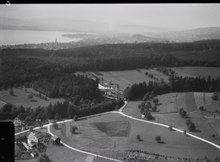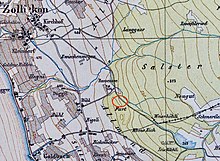Rumensee
| Rumensee | ||
|---|---|---|

|
||
| View over the Rumensee to the west when the water level is low. In the background the Albiskette and Lake Zurich | ||
| Geographical location | Canton Zurich | |
| Tributaries | Seepage water | |
| Drain | Rumenseebach → Düggelbach → Lake Zurich → Limmat → Aare → Rhine → North Sea | |
| Location close to the shore | Küsnacht ZH | |
| Data | ||
| Coordinates | 687 187 / 242564 | |
|
|
||
| Altitude above sea level | 546 m above sea level M. | |
| surface | 1.20 ha | |
| length | 200 m | |
| width | 75 m | |
| scope | 485 m | |
|
particularities |
Nature reserve |
|
The Rumensee is a lake in the municipality of Küsnacht in the canton of Zurich . It is classified as a nature reserve of national importance.
description
The artificially dammed Rumensee lies above the village of Küsnacht. It is surrounded by a belt of reeds , which numerous amphibians use as spawning grounds . A wide promenade leads around the lake. The lake is demarcated from the path by a fence to protect the reed area and the birds nesting in it. Direct access to the lake is therefore not possible; swimming and fishing are not permitted.
There are numerous barbecue areas and benches available on a large meadow on the east and south side. In a small building from 1937 there are toilets and a covered fireplace.
The inflow used to be through a narrow stream from the southeast, which was diverted from the Kusenbach around 100 meters away, but is now silted up or filled in. Today the Rumensee is fed exclusively by the water that seeps in from the east from the rising terrain. The outflow is through a small weir on the north side. The Rumenseebach follows the Zumikerstrasse in the direction of Zollikon , where it is picked up by the Düggelbach , which flows into Lake Zurich .
On the western side of the Rumensee, across the Zumikerstrasse, the 70th cemetery in Switzerland was opened in 2011 .
Surname
Until 1723, the Rumensee lay directly on the border with Zollikon in a depression that is still clearly recognizable today, where a forest road leads south, and gave the former inn "Waldhaus Rumensee" its name. This refers to an Alemannic named Ruomo or Rûmo . “Ruomins See” became “Rumensee” by means of a sound loop, just as the name Uolrich became Ulrich.
Probably in memory of the builder of the pond from Zollikon, the name "Zolliker Weiher" can be found on old maps for the Rumensee. The Zolliker, on the other hand, called it "Grossweiher"; this in contrast to the smaller mill pond in Zolliker Kleindorf, with whose water the mill was operated before 1723.
history

Today's Rumensee was excavated in 1723 by Zolliker Müller and jury Johannes Bleuler so that he could "better irrigate his garbage and make it more accessible during dry times and lack of water". Bleuler's mill in Kleindorf burned down in the summer of 1872 when the bankrupt owner Johann Heinrich Meier was set on fire and was not rebuilt. Meier's bankruptcy estate also included the “water pond and its surroundings”, which Johannes Honegger from Hochfelden bought for CHF 20,000 . After the fire in the mill and the abandonment of the saw in 1903, however, the pond lost its significance as a reservoir and repeatedly changed hands. The mechanic Heinrich Honegger, probably a son of Johannes Honegger and now resident in Zollikon, sold the pond in 1891 to the Zolliker Feilenhauer Gottfried Kunz, who passed it on in 1910 to the timber merchant Jakob Heer in the Zolliker "Höhe". In 1929 the Eis-Knecht company acquired the pond after having used it for many years to make ice for breweries. The company immediately had the entire property surrounded by a high wire fence so that the lake was no longer open to the public for walkers. Around this time the name "Zolliker Weiher" gave way to the name "Rumensee", which is still in use today - perhaps because of the name "Rumensee" on a barn from 1925.
In 1945 the rumor went that the owner wanted to fill the pond with rubble - a fate that had threatened the neighboring Schübelweiher in 1923, but could be averted. The owner of the Rumensee would have received compensation for a few thousand cubic meters of excavation and then gained 30,000 m² of usable land. After negotiations with the owner Ferdinand Knecht, the Küsnacht municipal assembly on June 28, 1946 approved the municipal council's proposal to buy up the pond and the surrounding area for CHF 85,000, a total of 30,179 m². Immediately afterwards the fencing was removed, making the Rumensee accessible to everyone again.
The close vicinity of the lake was secured, but not the wide green area that adjoins the east up to the Hinterried. Ideas after the war to create allotment gardens there came to nothing, but in 1949 there were concrete plans to build a large development there. After tough negotiations, the local council succeeded in convincing the owner Albert Uster-Schneider to sell, and so in 1950 and 1954 a total of 32,384 m² came into the possession of the community at a price of 237,000 francs. Another 20,400 m² above this area was owned by Küsnachters Viktor Naef (1875–1955), who bequeathed the property to the community as a gift to expand the green zone in 1949.
In 1963, plans by the community to build a house with three apartments in place of the barn that had to be demolished on Lake Rumensee, based on designs by architect Franz Jung, were dashed. They failed because of the resistance of the Küsnacht Improvement Association, which had been responsible for the facility at Lake Rumensee since 1952.
legend
At the Rumensee the legend plays "The monster from the Rumensee": In the ruins of the small St. Anna chapel west of the lake a monster is said to have dwelt, which is said to have frightened those returning late at midnight with the rattle of chains.
literature
- Walter Bruppacher: Around the Rumensee, in: Küsnachter Jahresblätter 1970, pp. 27–38
Individual evidence
- ↑ kuesnacht.ch
- ↑ Sharing the forest with the dead. In: Tages-Anzeiger from June 1, 2011.
- ^ Walter Letsch: On the history of the mills of Zollikon, in: Zolliker Jahrheft 2001, pp. 67–83
- ^ Adrian Michael: Sagenhaftes Zollikon, Kranich Verlag, 2017






